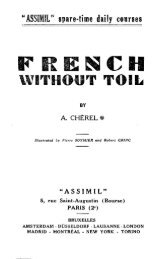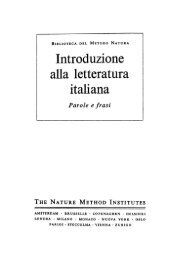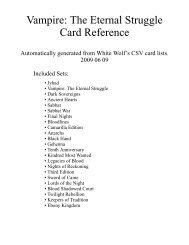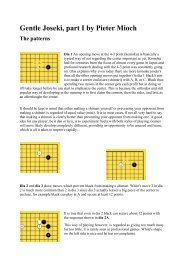Plains Cree: A Grammatical Study - Computer Science Club
Plains Cree: A Grammatical Study - Computer Science Club
Plains Cree: A Grammatical Study - Computer Science Club
Create successful ePaper yourself
Turn your PDF publications into a flip-book with our unique Google optimized e-Paper software.
40 [TRANS. AMER. PHIL. SOC.<br />
classification). In <strong>Cree</strong>, however, the evidence for<br />
this subtype is inconclusive, and further informant<br />
work is required before a fuller statement can be<br />
attempted.<br />
5.14. Inanimate Intransitive<br />
Inanimate intransitive (II) verbs are always<br />
intransitive. (Cf. also 6.43.)<br />
5.2. PARADIGM TABLES<br />
The basic paradigms are presented here to summa-<br />
rize the data which are analyzed in this chapter.<br />
Without this aid to orientation, the analytic sections<br />
might be difficult to follow. The paradigms may<br />
also serve as a practical reference guide in the identifi-<br />
cation of newly encountered forms.<br />
5.21. Sources<br />
With the exception noted below, the tables only<br />
include forms which are textually attested, either in<br />
my own or in Bloomfield's texts.<br />
A few forms which are not attested in the texts<br />
are cited in parentheses. These forms are considered<br />
to be of fairly high authenticity since they are uni-<br />
formly given by the four major missionary sources<br />
on <strong>Plains</strong> <strong>Cree</strong> (Lacombe, Hunter, Lessard, Edwards).<br />
They are also at least partially confirmed by the<br />
remainder of their respective paradigms.64<br />
5.22. Empty Positions<br />
A paradigmatic position which is left empty in<br />
principle presents a choice of two interpretations:<br />
either no such form exists, or it has not been recorded.<br />
The non-existence of a form for a paradigmatic<br />
position may reflect the neutralization of a contrast;<br />
this is indicated by the layout and the choice of<br />
parameters. For example, contrast the direct and<br />
inverse third-person sets of the TA independent<br />
indicative paradigm. Other cases may involve se-<br />
mantic restrictions (e.g., TA imperative 21-1) or<br />
they may correlate with the development of suppletive<br />
forms (e.g., the indefinite form of the AI independent<br />
indicative paradigm). In such cases, the fact that<br />
no form exists is indicated by a dash: - .<br />
Where a lacuna is considered accidental, it is<br />
indicated by empty brackets: [ ]. In the present<br />
tables, this type is restricted to the conjunct non-<br />
indicative (subjunctive and iterative) paradigms<br />
which are readily derived from the conjunct indicative<br />
paradigms (cf. 5.33).<br />
Since the various preterit and dubitative paradigms<br />
are very incompletely attested, they are presented<br />
4 No attempt is made to incorporate the incredible diversity<br />
of paradigms found in missionary sources; while composite pre-<br />
sentation would obviously open interesting perspectives, practical<br />
difficulties and problems of interpreting these sources preclude<br />
such an approach in the present context.<br />
WOLFART: PLAINS CREE<br />
as lists rather than two-dimensionally. They follow<br />
the remainder of the basic paradigms.<br />
5.23. Level of Representation<br />
The paradigms are given in phonemic represen-<br />
tation; cf. appendix A, especially footnote 85. How-<br />
ever, to facilitate use of these tables for quick reference<br />
purposes, suffix-initial i which reflects the palatalizing<br />
/i/ (rather than /e/) is underlined (cf. appendix A: 2).<br />
The codes for the person-number-gender-obviation<br />
categories are defined in table 1 of section 2.01.<br />
For the alternant forms of the personal prefixes, see<br />
appendix A: 6. Direct and inverse are discussed in<br />
2.5, and the terms mixed, third-person, and you-and-me<br />
are introduced in 5.611 and 5.612.<br />
5.24. Versions of the TA Independent<br />
Indicative Paradigm<br />
The TA independent indicative paradigm is pre-<br />
sented in two versions; version B is omitted for the<br />
TA conjunct. The rationale for this double presen-<br />
tation is discussed in detail in sections 5.61-5.63.<br />
Version A reflects the semantic structure of the<br />
paradigm as a whole, as well as the morphemes<br />
actually present in each form; thus, there is no<br />
obviative (3') morpheme present in wapamew 'he sees<br />
him.'<br />
Version B reflects the syntagmatic relations entered<br />
into by each individual form; for example, refer-<br />
entially and with regard to concord, wapamew 'he<br />
sees him' has a proximate (3) actor as well as an<br />
obviative (3') goal.<br />
TABLE 5<br />
SUMMARY OF VERBAL PARADIGMS<br />
Basic paradigms:<br />
TA independent indicative<br />
(A: meaning and morphemes present)<br />
TA independent indicative<br />
(B: reference)<br />
TA conjunct simple and changed<br />
(indicative)<br />
TA conjunct subjunctive and iterative<br />
TA imperative<br />
AI<br />
TI<br />
II<br />
Incompletely attested paradigms:<br />
Preterit (TA, AI, TI, II)<br />
Dubitative (TA, AI, TI)<br />
Marginal and suppletive paradigms:<br />
Relational (AI, TI)<br />
Diminutive (TA, AI, TI)<br />
TA inanimate actor<br />
TA indefinite actor<br />
AI, TI indefinite actor<br />
AI inanimate actor<br />
Table 6<br />
Table 7<br />
Table 8<br />
Table 9<br />
Table 10<br />
Table 11<br />
Table 12<br />
Table 13<br />
Table 14<br />
5.813<br />
5.82<br />
5.83<br />
5.84<br />
5.85<br />
5.86









